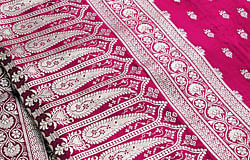Bhakti Bapat Mathew describes the five most popular Indian silk saree weaves

India silk saree weaves are easily among the most glamorous and colourful silk weaves in the whole world. Be it the gorgeous golden floral motifs on the Kanchipuram, or the peacock design on the Paithani, the splendour of the Indian silk saree is breath-taking and unique.
Traditionally, every region in India has had its own unique weave for the silk saree. Here are the top five silk weaves that are a must in every Indian woman’s wardrobe.
Kanchipuram weave
Also known as Kanjeevaram, the Kanchipuram is probably the most sought-after saree in a bridal wardrobe. Woven primarily in the town of Kanchipuram in Tamil Nadu, the classic Kanchipuram is made from pure mulberry silk and gold zari and is known for its durability and splendour. Every year, the Indian wedding season sees thousands travelling to the cities of Chennai and Kanchipuram to get the best Kanjeevaram silks at the best possible prices.
This hand-woven silk saree uses three single silk threads twisted together with zari. The zari consists of a silk thread rolled with silver wire and dipped in pure gold. The combination of gold, silver and pure silk makes the Kanchipuram a majestic but expensive saree. The Kanchipuram weave is made using the double-warp, double-weft technique, giving it a two-layered, strong finish. The modern Kanchipuram has evolved to include in its design embroidery, crystals, and non-traditional motifs and colours.
One of the characteristics of the traditional Kanchipuram is contrasting colours.
In a traditional, hand-made Kanchipuram, the body of the saree, the pallu, and the border are created individually and then brought together. The motifs on the traditional Kanchipuram usually consist of temple towers, flower patterns, birds, or the “rudraksha” motif.
The traditional Kanchipuram is found in bright red, orange, green, or maroon colours.
Banarasi weave
Like the Kanchipuram, this is a favourite for the bridal wardrobe. Completely hand-made, it can take anywhere from 15 days to a month to complete a classic Banarasi silk saree. But the time and effort are well worth it. In the ancient days, Banarasi silk was a mainstay in the wardrobe of the Moghul royals. A Banarasi silk lends instant glamour and elegance.
The heavy, gold-silver Banarasi brocade is a work of art. The saree is characterised by its intricate weave and zari work. The weave consists of silk warp and weft brocaded with additional weft motifs in varying patterns like creepers, bells etc. The Banarasi pure silk weave is known as katari.
A Banarasi silk saree usually has Moghal, Persian or Egyptian style motifs including intricate floral patterns, animals and architectural patterns.
A typical element of a Banarasi silk is a slim, fringe-like design similar to a string of vertical leaves, along the border.
Paithani weave
Few silk sarees are made as painstakingly as the Paithani. The pride of Maharashtra, worn by the Peshwa royals and now considered to be a luxury item, the saree is chiefly made in the town of Paithan. Needing 2-6 months for completion of a single saree, the Paithani is truly a labour of love.
The Paithani weave is characterised by gold zari and silk weave. The Paithani consists of a plain weave, which has weft designs along the lines of a tapestry. The pallu of the saree usually has a gold base with silk pattern, which gives it a distinctive, “embossed” look.
The typical motifs of the Paithani include the lotus, parrots, peacocks, coconut and floral vines.
Since Paithan is located close to the Ajanta Caves in Maharashtra, the motifs of the Paithani are inspired by the Buddhist art seen in the caves.
Dharmavaram weave
Dharmavaram silk sarees come from Andhra Pradesh, home to a number of unique saree weaves. Made in the town of Dharmavaram in the district of Anantapur, a Dharmavaram saree is characterised by brilliant colours, rich artistry and a double shading effect.
The Dharmavaram silk saree is made of silk fabric that can be easily dyed. The pallus are intricately designed.
The Dharmavaram silk saree is characterised by borders without too much contrast. The border usually has brocaded gold dot motifs.
Patola weave
Created in Patan in Gujarat, Patola silk is considered to be among the best hand-woven silk in India. Patola sarees can be vertically-resist dyed, called single ikat. Or, they may be horizontally-resist dyed, called double ikat. The entire process of creating a Patola silk saree can take up to six months. The Patola silk saree has complex, five-colour patterns resist-dyed into weft and warp threads before weaving begins. Patola silks are characterised by blazing and bright colours, and geometric patterns mixed with folk motifs.
The Patola silk saree looks alike from both sides, and so can be worn both ways.
Wearing Your Silks
You can wear these stunning silk weaves for traditional parties, during festivals, and during Indian weddings and ceremonies. You can dress up in your silk saree in the traditional Indian way. This by itself can be a gorgeous ensemble. However, if you want a more contemporary and edgy look, you can go for an Indo-Western look.
The Indo-Western ensemble can be fun and stylish. You can pair up your saree with a spaghetti blouse or a halter neck choli. Alternatively, you can go for stylishly cut tunics made from plush Banarasi silk. Better yet, you can go for dresses or skirts in flattering silhouettes made from your Indian silk weave.
Finally, remember that few things match the timeless elegance of the Indian silk saree. A silk saree, if maintained carefully, can stay beautiful for decades. The silk saree then, is not just a fashion trend. It is truly a legacy that can be passed on to future generations.